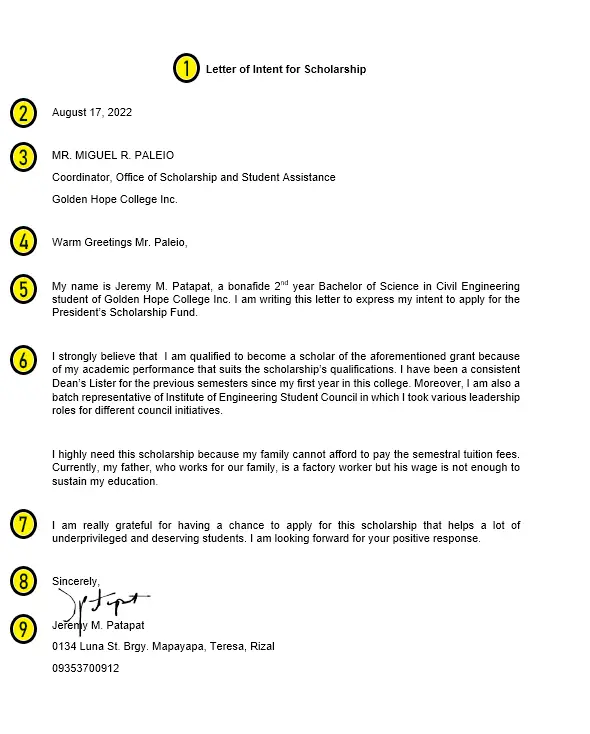How To Write Letter of Intent for Scholarship in the Philippines (FREE Sample Templates)

Letter of Intent (LOI) is usually one of the documentary requirements you must submit to apply for a scholarship. Unlike your Transcript of Grades or Certificate of Good Moral Character, an LOI is not released by a particular office. Instead, you have to write one on your own.
In this article, we’ll guide you on how to write a letter of intent that helps you ace the scholarship you’re aspiring for.
Table of Contents
- At a Glance: Letter of Intent for Scholarship Templates (Free Download)
- 1. Letter of Intent for University-Based Scholarship (for College Students)
- 2. Letter of Intent for School-Based Scholarship (for High School Students)
- 3. Letter of Intent for Government Scholarship
- 4. Letter of Intent for Private Scholarship
- 5. Letter of Intent Addressed to a Public Official (i.e., Mayor, Governor, Congressman)
- 6. Letter of Intent for Post-Graduate Scholarship
- 7. Letter of Intent for Foreign Scholarship
- What Is a Letter of Intent (LOI) for a Scholarship?
- What Is the Difference Between a Letter of Intent and an Application Letter for a Scholarship?
- What Does the Letter of Intent for Scholarship Look Like?
- How To Write a Letter of Intent for a Scholarship
- 1. Gather Important Details Related to the Scholarship You’re Applying For
- 2. Write the Letterhead and Salutation
- 3. Introduce Yourself and Indicate Your Intent To Apply for the Scholarship
- 4. Briefly State Your Qualifications, Experiences, Academic Performance, and Other Reasons Why You Deserve the Scholarship
- 5. Express Your Gratitude to the Letter’s Recipient
- 6. Conclude Your Letter
- Tips and Warnings
- References
At a Glance: Letter of Intent for Scholarship Templates (Free Download)
No time to write your LOI for a scholarship? Fret not, as you can choose from any downloadable and editable LOI for scholarship templates below. Just click the link and wait for the Microsoft Word file to download.
1. Letter of Intent for University-Based Scholarship (for College Students)
2. Letter of Intent for School-Based Scholarship (for High School Students)
3. Letter of Intent for Government Scholarship
4. Letter of Intent for Private Scholarship
5. Letter of Intent Addressed to a Public Official (i.e., Mayor, Governor, Congressman)
6. Letter of Intent for Post-Graduate Scholarship
7. Letter of Intent for Foreign Scholarship
What Is a Letter of Intent (LOI) for a Scholarship?

A letter of intent is a formal document that informs the reader about your intention to perform something that they must give attention to. So, an LOI for scholarship emphasizes someone’s desire to become a scholar of a specific institution or organization.
For instance, the Quezon City Government requires students taking specialized courses to submit a Letter of Intent to the Mayor1. If someone submits an LOI for this scholarship, he/she is informing the assigned office that manages this scholarship about his/her intention to become a scholar of the Quezon City Local Government.
What Is the Difference Between a Letter of Intent and an Application Letter for a Scholarship?
The main distinction between the two lies in the purpose they serve. An LOI is focused more on sending a clear message regarding your desire to apply for a scholarship. The letter’s message of intention is supported by a summary of your qualifications, academic achievements, and so on. Thus, an LOI is usually short and simple.
On the other hand, application letters are focused more on highlighting yourself to show that you’re the top choice for the grant. Although this letter has a formal tone, you can include some personal anecdotes and testimonials from your referrals to make it more convincing. In short, an application letter is more “fleshed-out” than an LOI.
An application letter is also more tailored to fit a particular scholarship program. For instance, if the scholarship looks for students with high mathematical aptitude, the application letter will be geared towards an in-depth discussion of someone’s mathematical ability (math competitions won, grades in math subjects, etc.).
What Does the Letter of Intent for Scholarship Look Like?

- Title: This indicates that the document is an LOI for a scholarship
- Date: This part indicates the date when the letter was sent to the recipient
- Letterhead: Shows your recipient’s information (name, position, institution, etc.)
- Salutation: Short greeting for the recipient. If you’re uncertain about the letter’s recipient, use “To whom it may concern.”
- Introduction: This contains a brief introduction of yourself and your intention to apply for a scholarship.
- Body: This elaborates on your qualifications, academic performance, and other reasons why you deserve to have the scholarship.
- Concluding paragraph: This is where you express gratitude to the reader and wrap up the letter
- Closing remark: This includes a short formal closing statement
- Sender’s information and signature
How To Write a Letter of Intent for a Scholarship
1. Gather Important Details Related to the Scholarship You’re Applying For
Before drafting your LOI, research the scholarship you’re applying for. This is to ensure that every detail you put in the letter is accurate.
Here’s some information that you need to look for:
- Name of the scholarship (e.g., President’s Scholarship Fund)
- The institution that offers the scholarship (i.e., university, local government, NGO, etc.)
- The department/office that facilitates the scholarship application (e.g., Office of Student Affairs, Office of Scholarship and Financial Assistance, etc.)
- Coordinating person or officer that facilitates the scholarship application
2. Write the Letterhead and Salutation
Based on the information you’ve collected from your research, you can now start writing your LOI. Complete the letterhead by writing essential information about the recipient (i.e., name, position, institution, address, etc.).
Afterward, write a formal salutation to the letter’s addressee. You may use words such as “Dear …”, “Greetings…”, and so on.
3. Introduce Yourself and Indicate Your Intent To Apply for the Scholarship
Let’s now write the letter’s body. The first paragraph must include your name and current educational attainment. If you’ve graduated recently and are enrolling in a new school, you must state your alma mater.
The most crucial part of the introduction is your statement of intent, so you must clearly state it. However, most institutions offer a variety of scholarship grants, so you need to specify which of those you want to apply for.
In the example above, the sender specified that he wants to apply for the “President Scholarship Fund.” Note that he didn’t just write that he wants to apply for a scholarship (which sounds too broad).
You may also indicate how you’ve learned about this scholarship (although this is optional).
4. Briefly State Your Qualifications, Experiences, Academic Performance, and Other Reasons Why You Deserve the Scholarship
It depends on how many paragraphs you allot for this step. The purpose of this section is to convince the reader that you’re qualified to become their scholar.
However, make this portion concise and straightforward. In the letter above, the sender just provides an overview of his academic qualifications and extra-curricular experiences. In the succeeding paragraph, the sender mentioned his economic conditions, which is another reason he deserves the grant.
5. Express Your Gratitude to the Letter’s Recipient
For your LOI’s last paragraph, thank the recipient for giving you a chance to apply for their scholarship.
6. Conclude Your Letter
Close your letter by affixing your signature and indicating your contact details.
Tips and Warnings
- Make it short and sweet. If possible, keep the letter one page long only. No need to use highfalutin words or lengthy sentences.
- Don’t forget to proofread. To avoid delays in the processing of your scholarship application, check the accuracy of the information indicated in the letter, such as the recipient’s name, address, institution, and so on.
References
- How To Apply For Scholarship. Retrieved 31 August 2022, from https://quezoncity.gov.ph/qcitizen-guides/how-to-apply-for-scholarship/
Written by Jewel Kyle Fabula
Jewel Kyle Fabula
Jewel Kyle Fabula graduated Cum Laude with a degree of Bachelor of Science in Economics from the University of the Philippines Diliman. He is also a nominee for the 2023 Gerardo Sicat Award for Best Undergraduate Thesis in Economics. He is currently a freelance content writer with writing experience related to technology, artificial intelligence, ergonomic products, and education. Kyle loves cats, mathematics, playing video games, and listening to music.
Copyright Notice
All materials contained on this site are protected by the Republic of the Philippines copyright law and may not be reproduced, distributed, transmitted, displayed, published, or broadcast without the prior written permission of filipiknow.net or in the case of third party materials, the owner of that content. You may not alter or remove any trademark, copyright, or other notice from copies of the content. Be warned that we have already reported and helped terminate several websites and YouTube channels for blatantly stealing our content. If you wish to use filipiknow.net content for commercial purposes, such as for content syndication, etc., please contact us at legal(at)filipiknow(dot)net
